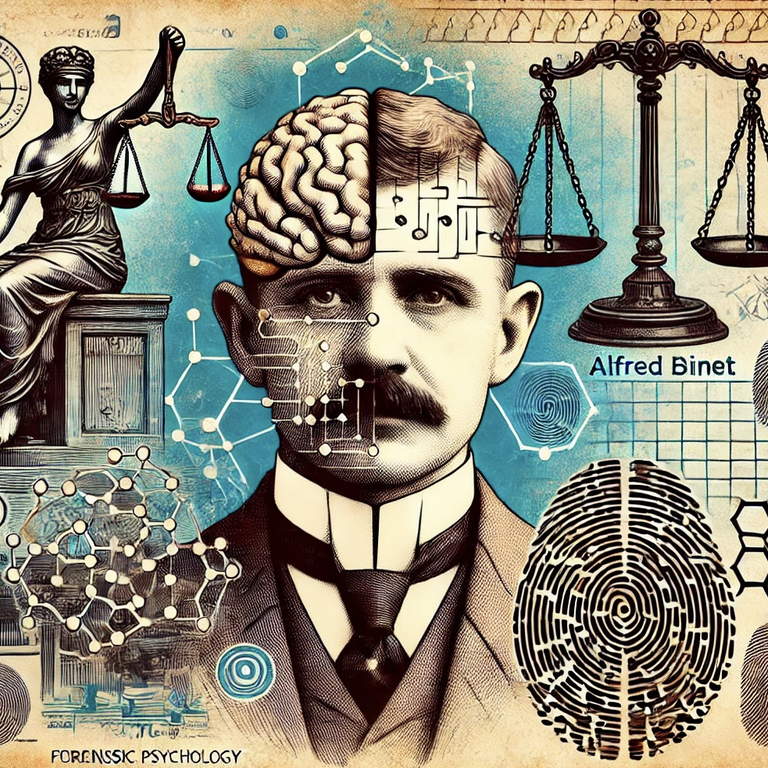The Life of Alfred Binet
Alfred Binet has made significant contributions within the field of psychology, although most of his research did not gain the popularity it deserved. He is most recognized for his development of the first standardized intelligence test, even though for most of his career he was focused on many other areas. The purpose of this paper is to explore the life of Alfred Binet up until his death, going into greater detail in many areas of his research, how he has contributed to today’s knowledge in the field of psychology, and why he is not as recognized as he should be for his discoveries.
Binet was born in 1857 in Nice, France, and was the only child of wealthy parents; his father, Edoardo Binet, a physician, and his mother, Moina Allard, an artist. After his parents went through a divorce, he lived solely with his mother. At age 15 they both moved to Paris where he completed high school, and then went ahead and earned his law degree at the University of Paris, in 1878. He never ended up practicing law or trying to start a legal practice of his own; instead he briefly attended medical school before eventually dropping out.
Surprisingly, Alfred Binet never received any formal schooling in psychology and is considered to be a self-taught psychologist. After his attempt and eventual drop from medical school, he began reading books in the National Library of Paris in 1879 and gained interest in the field of psychology. On his own, he studied the theories, and read the books and articles of many of the major psychological thinkers, including: Taine and Ribot, with a focus on the associationists Alexander Bain, Herbert Spencer, and John Stuart Mill. By 1880, Binet published his first article on the two-point threshold in Revue philosophique, with the help of Ribot’s sponsorship. The article had many errors, leading to the first of many critiques of Binet’s work by Belgian physiologist Joseph Delboeuf. In 1882 Joseph Babinski, a former classmate of Binet’s and at this time was now a neurologist introduced Binet to Jean Martin Charcot and Charles Fere. Both Charcot and Fere worked at the Salpetriere, a teaching hospital in Paris, which is now one of the largest in all of Europe.
From 1883-1890, Binet was able to conduct his research at the hospital, by volunteering as an unpaid assistant of Charcot’s. In 1884, he married Laure Balbiani, the daughter of a well-known biologist who held professorship at the College de France. Together they had two daughters, Madeleine in 1885 and Alice in 1887. In 1886, Binet wrote a report on exterior perception, which he later won an award for at the Academie des Sciences Morales et Politiques. Also in 1886, he published his first book La Psychologie du raisonnement; and in 1887, another book called Le magnetisme animal. Etudes de psychologie experimentale, a book Binet helped write that focused on the psychic life of microorganisms, hypnosis and hysteria, was also published, in 1888.
During his time at the hospital, and under the influence of Charcot, They obtained the same results as Charcot had in his own research, and were from then on believers in its validity. Binet was considered by many an aggressive proponent of Charcot’s grand hypnotisme; many believe this was due to the fact that Binet was offered his first position in the field of psychology by Charcot, and in return put a blind faith into his work.
The Nancy school of hypnotists challenged the findings of Charcot, Fere, and Binet. Binet continued to defend their work until Delboeuf, the same person who wrote the critique on Binet’s first published work, published yet another critique in 1886 on the errors in how Binet conducted his research. A short time after the critique was published, Binet admitted that his results might have been marred unintentionally through the effects of suggestion. Binet was embarrassed and eventually left the group he had been working with in 1890. By the end of his time at the Salpetriere, he had written twenty articles and three books with information in many areas of psychology: illusions of movement, alterations of personality, attention and reasoning, and a subject which he termed himself sexual fetishism.
For the next year after, Binet was unaffiliated with any institution, and instead conducted home experiments on his two daughters, using various puzzles and mental tests. In 1891, he met someone at the Rouen train station by the name of Henri-Etienne Beaunis, who happened to be the director of France’s first experimental psychology lab, called the Laboratory of Physiological Psychology at Sorbonne. Soon after, Binet volunteered to work as an unpaid assistant, under the direction of Beaunis. Only a year later, Binet became deputy director of the laboratory; By 1893, he started issuing a newsletter a newsletter at the lab, Bulletin des Travaux du Laboratoire de Psychologie Physiologique.
In 1894, Binet replaced Beaunis and gained the title of director, which was still an unpaid position. In the same year, he founded the first French psychological journal called L’Annee psychologiqu, and he also earned a Ph.D. in natural science; his dissertation being on the anatomy and physiology of the sub-intestinal nervous system of insects. The L’Annee psychologiqu is focused on laboratory research, and still regularly issued as of today. As the director of his Sorbonne laboratory, Binet conducted many experiments and case studies on many of France’s most well known authors, as well as a small group of chess and mathematical calculation prodigies. He also studied young children’s visual memories, and demonstrated how easily it was to influence their recall of such memories.
Much of the same information discovered in modern conformity studies had already been suggested by Binet in his book, La Suggestibilite. In 1896, along with another one of his students named Victor Henri, Binet proposed “Individual Psychology”, which was a program designed to produce a profile of an individual through the use of a series of short tests. At this time, most research being conducted on intelligence was focused on easy-to-measure aspects of cognition, such as reaction speed or sensory feedback. “Individual Psychology” instead emphasized the complex mental processes, such as memory and comprehension.
In 1897, with the help of Edouard-Gerard Balbiani, an embryologist, Binet founded and directed Intermediaire des Biologistes. Organe International de Zoologie, Botanique, Physiologie et Psychologie. The journal was not affiliated with any school, and was created with the purpose of creating just another outlet of communication for psychologists. In 1899, Theodore Simon and Henri Pieron joined the lab, and began working under Binet at Sorbonne. Simon provided many needed test subjects and helped Binet continue building upon the work that had been started with “Individual Psychology”. Around this time, Binet joined the La Societe Libre Pour l’Etude Psychologique de l’Enfant (SLEPE), the free society for the psychological study of the child, which was a group of teachers, psychologists, and school administrators that were all involved in current educational issues. By 1902, he became its president.
In 1903, Binet published his book, L’Etude Experimentale de l’Intelligence, which explained certain exercises that he used and noted their results. Today, they are referred to as projective tests, which included: responses to ink blots, imaginative storytelling in response to stimuli, sentence-completion questionnaires. It is worth noting that the inkblot tests that Binet described in his book took place about ten years before Herman Rorschach, the name today, which is associated with the inkblot tests, began using them. The same book also made suggestions claiming imageless thought existed. This information was never recognized until other psychologists from the Wurz-burg school published the same concept over four years later. Also in 1903, a new committee of the SLEPE was formed, with the sole purpose of studying the differences between normal and abnormal children. The Minister of Public Education, Joseph Chaumie, created a Ministerial Commission in 1904 which took responsibility for figuring out how to deal with “abnormal” children in their government’s education system, which was now a growing public concern. After hearing of this, Binet was more convinced of the importance of his research at the SLEPE and began to focus more on his “experimental pedagogy” with the help of Simon and to a lesser extent Henri Damaye; throughout this time continued to conduct tests on his daughters at home. By 1905, Binet was named Secretary of the pedagogical subcommittee of the commission.
On April 21, 1905, Beaunis presented a summary of Binet and Simon’s recent work to the International Congress in Rome, which was the first version of the first Binet-Simon intelligence scale to be shared internationally. Along with the test, three different approaches were emphasized that would have to be used to effectively diagnose the degree of intelligence a child possessed: a medical, pedagogical, and psychological approach. They claimed the medical and pedagogical methods, which were both acknowledged as being important, would only be able to identify possible signs of retardation, while the psychological method led to a more certain indicator of intellectual ability. The pedagogical approach, which was aimed at evaluating intelligence based on the child’s acquired knowledge, was not always an accurate measurement because the quality of education they received could skew the results.
In July of 1905, the first version of the Simon-Scale of intelligence was published in L’Annee Psychologique. Up until this point, there was no reliable standardized test for intelligence in existence; except for the Western world, the test was not widely accepted or used until after Binet’s death, not until the late 1920’s for France. The development of this test is what Binet is most recognized for today, as it was able to establish a “progressive metric scale of intelligence”. The test was created within only a few weeks, consisting of 5 subtests and 25 abstract questions that had been based on fifteen years of Binet’s research; certain sections, including the test which measured short-term memory and produced by Jacobs in 1887, were directly taken from other studies. The sample size for testing the validity of the original Binet-Simon scale only consisted of 50 children. It was also the first intelligence test to arrange the questions in order of ascending difficulty; this concept is still used in the current versions of the Standford-Binet scale being used today. Many of the subtests as well as specific questions in the test being used today were also included in the original 1905 scale.
From 1905 until his death in 1911, Binet spent a large amount of his time revising his test, though he was still able to make time for other endeavors. He published more than 100 articles on courtroom testimony, psychotic patients, language, mental fatigue and it’s effects on intellectual performance, and others that focused on his progression of revisions for the intelligence test. In October 1905, Binet established the laboratory-school at Grange-aud-Belles, where he continued his research along with Simon. In January of 1907, the first of five experimental “special” classes were opened up Paris. The same year, he found that 5% of children that had difficulty in school were not mentally handicapped, but it was due to the fact that they could not see the blackboard. Binet and Simon then produced a vision test that was easy enough for teachers to use; another example of a small contribution made by Binet.
From 1909-1910, Binet and Simon worked together on publishing a series of articles focused on mental deficiencies and psychoses, titled “mental alienation”; these articles became popular and were widely used in medical schools for over 15 years after Binet’s death. Both Binet and Simon also revised the intelligence test once in 1908 and another revision in 1911; this time more effort was placed validating these subsequent versions with a larger sample of children. At the age of 54, Binet died due to a cerebral hemorrhage.
Binet gained most of his popularity through his development of the first standardized intelligence test, and probably one of his most significant contributions. Even though Binet never intended for his test to quantify a person’s intellectual ability, psychologists continued to use, revise and interpret it in their own way. Louis William Stern started the idea of an intelligent quotient by taking a ratio of mental age over chronological age. Shortly after, Lewis M. Terman went ahead and multiplied that quotient by 100, the resulting number what we now refer to as the “IQ”. Although Binet would probably not agree with the way his test has been used to quantify intelligence, without his work, intelligence testing would not have progressed the way it has.
For most of his life, he spent most of his time focused on other intellectual efforts other than the test; he never even held a job in a paid position. His ability to conduct research was only possible because of his independent income. He made contributions in many academic fields including natural sciences, physiology, and many areas of psychology. As noted throughout the paper, in many cases his methods used and his suggestions based off his research actually predated better-known studies. Over his lifetime he wrote over 200 reviews, books, and articles that were published in various journals. He even founded many journals himself, some of which are still produced today, including: Intermediaire des Biologistes. , Bulletin des Travaux du Laboratoire de Psychologie Physiologique, Physiologie et Psychologie, Botanique, as well as Annee Psychologique.
The Lasting Impact of Alfred Binet on Our Understanding of the Criminal Mind
Alfred Binet, best known for developing the first intelligence test, laid foundational work that extends far beyond educational psychology. His contributions have had a profound influence on how we understand the criminal mind today, providing insights into the cognitive and psychological factors that may contribute to criminal behavior.
The Binet-Simon Scale and Intelligence Testing
Alfred Binet, along with his colleague Théodore Simon, developed the Binet-Simon Scale in 1905. This was the first standardized test designed to measure intelligence. Although Binet’s primary goal was to identify children who needed special educational assistance, his work inadvertently opened doors to exploring the cognitive aspects of criminal behavior.
Binet’s intelligence tests helped to establish a framework for understanding cognitive deficiencies, which could be linked to certain types of criminal behavior. The notion that lower intelligence might be associated with impulsivity, poor decision-making, and difficulty understanding the consequences of actions has influenced criminologists and psychologists for decades. These ideas have been used to explain why some individuals may be more prone to criminal activity, particularly crimes that require less planning and foresight.
The Evolution of Forensic Psychology
Binet’s influence can also be traced to the evolution of forensic psychology, a field that examines the intersection of psychology and the criminal justice system. His work on intelligence testing highlighted the importance of psychological assessment in understanding individual differences, including those that might predispose someone to criminal behavior.
Forensic psychologists today often use assessments that have roots in Binet’s methodologies to evaluate defendants’ cognitive abilities, mental health status, and potential for rehabilitation. These assessments can determine whether a defendant is competent to stand trial or whether their cognitive impairments should be considered during sentencing. Binet’s legacy is thus deeply embedded in the forensic evaluation process.
Understanding Suggestibility and Its Role in Criminal Justice
One of Binet’s lesser-known but significant contributions was his research on suggestibility, particularly in children. He demonstrated how susceptible people could be to external influences, a concept that has important implications for criminal investigations and legal proceedings.
In the context of eyewitness testimony, Binet’s research underscored the potential for memory distortion due to suggestive questioning or environmental factors. This understanding has been pivotal in shaping modern approaches to interrogations and the use of eyewitness testimony in courtrooms. Today, forensic psychologists and legal professionals are acutely aware of the risks associated with suggestibility, thanks in part to Binet’s pioneering work.
The Link Between Cognitive Development and Criminal Behavior
Binet’s interest in cognitive development also paved the way for research into how developmental stages influence behavior. This has led to a deeper understanding of how delayed or impaired cognitive development can increase the likelihood of criminal activity.
Modern research in developmental psychology often references Binet’s theories when exploring the links between early childhood experiences, cognitive development, and later criminal behavior. Programs aimed at early intervention and prevention of juvenile delinquency frequently draw on principles rooted in Binet’s work.
The Ethical Implications of Binet’s Work
While Binet’s contributions have been invaluable, they also raise ethical considerations, particularly regarding the potential for misuse of intelligence testing. The history of eugenics and the use of IQ tests to justify discriminatory practices serve as a reminder of the power and responsibility that comes with psychological assessment.
Today, forensic psychologists and criminal justice professionals are tasked with ensuring that Binet’s tools and theories are applied ethically, focusing on rehabilitation and understanding rather than stigmatization and punishment.
Final Thoughts
Alfred Binet’s impact on the field of psychology extends far beyond the classroom. His work laid the groundwork for understanding the cognitive aspects of criminal behavior, the importance of psychological assessment in legal contexts, and the ethical considerations that must guide the use of these tools. As we continue to explore the complexities of the criminal mind, Binet’s contributions remain a cornerstone of modern forensic psychology, shaping how we assess, understand, and respond to criminal behavior in today’s society.








